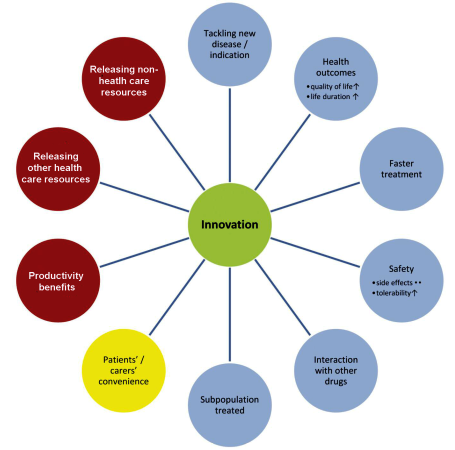Sign up to our newsletter Subscribe
Understanding societal preferences for priority by disease severity in England & Wales

Sign up to our newsletter Subscribe

Now available from the OHE website, this report provides a clear explanation of the complex nature of innovation in medicines. A fully revised and expanded version of the 2005 edition of The Many Faces of Innovation, it updates the review…

Now available from the OHE website, this report provides a clear explanation of the complex nature of innovation in medicines. A fully revised and expanded version of the 2005 edition of The Many Faces of Innovation, it updates the review of the literature on the economics of innovation, traces important innovation that has occurred since the earlier report, adds new case studies, and updates the discussion of competition in pharmaceutical R&D.
Now available from the OHE website, this report provides a clear explanation of the complex nature of innovation in medicines. A fully revised and expanded version of the 2005 edition of The Many Faces of Innovation, it updates the review of the literature on the economics of innovation, traces important innovation that has occurred since the earlier report, adds new case studies, and updates the discussion of competition in pharmaceutical R&D.
In the context of increasing pressure on health care payers in Europe, the definition of what constitutes “innovation” has become both muddled and dichotomised. The report summarises the wide variety of attributes that characterise innovation, including not only health gains, but also patients’ and carers’ convenience, and other societal gains and cost savings.
Innovation, the report explains, is both an unpredictable and a cumulative process, characterised by small steps and incremental learning. Upsetting that progression by skewing incentives, it warns, can have a negative impact on improvements in therapy over time and also affect other areas of society, outside health.
Also discussed in the report is the importance of encouraging dynamic competition among companies researching in overlapping areas. Distinct from any products eventually produced, these include price competition encouraged by alternative treatments; enough research on similar compounds to identify those with the greatest value; and R&D “spillovers”, whereby various types of knowledge gained benefit other research and other sectors.
Download Mestre-Ferrandiz, J., Mordoh, A. and Sussex, J. (2012) The many faces of innovation. Report for the ABPI. London: Association of the British Pharmaceutical Industry.
An error has occurred, please try again later.
This website uses cookies so that we can provide you with the best user experience possible. Cookie information is stored in your browser and performs functions such as recognising you when you return to our website and helping our team to understand which sections of the website you find most interesting and useful.
Strictly Necessary Cookie should be enabled at all times so that we can save your preferences for cookie settings.
If you disable this cookie, we will not be able to save your preferences. This means that every time you visit this website you will need to enable or disable cookies again.
This website uses Google Analytics to collect anonymous information such as the number of visitors to the site, and the most popular pages.
Keeping this cookie enabled helps us to improve our website.
Please enable Strictly Necessary Cookies first so that we can save your preferences!

